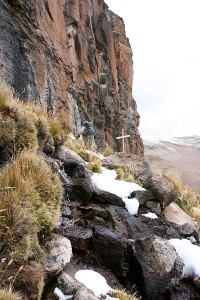
Photo by Jialiang Gao, via Wikimedia Commons.
While several countries have sent sports teams to Brazil, one country has sent something much more important. The massive Amazon River, providing life to the rainforest that houses a third of all species in the world, originates from a small glacial stream in Peru.
The Amazon meanders through Brazil all the way from its western borders to the Atlantic ocean in the east. Along the way, it picks up streams from all over the northern half of South America, but by definition the origin of a river is the source that is furthest away from the end of the stream. For the Amazon, that source is found on a mountain in the Peruvian Andes, called Nevado (snowy) Mismi.
Mismi was first identified as the origin of the Amazon by Loren McIntyre in 1971. Jacques Cousteau’s 1982 Amazon Expedition also led to Mismi as source. Other expeditions confirmed this in 1996, 2001, and 2007. So, we’re pretty sure that this insignificant-looking pond in the Andes is the furthest source of the largest river in the world.
According to Wikipedia, the site is only marked by a small wooden cross (see photo above), but when Ed Stafford set out to walk the full length of the Amazon from source to sea in 2008, he discovered that this was not entirely true:
“Within minutes we could see the cross and scrambled up the rocks to get to it. On our way we found a plaque announcing we were at the source. We ignored it and pushed on as “Wiki” can’t be wrong.
When we arrived at the source it was as we imagined: a steady spring of water coming out of the cliff above us and a nice white wooden cross. We took lots of photos but as we were about to leave we saw, twenty meters below, an iron cross. On inspecting, this cross had been erected by another expedition, this time in 1971.”
There is no single source at Mismi. Glacial streams emerge from the rocks at various places at different times. Stafford continues:
“Four completely separate teams have given four different locations as the source. The mountain is glaciated and covered in snow, there are water bodies and sub-glacial streams galore above all four “sources”.
So we decided to stop playing the silly “which source is the true source?” game and decided that we were happy that we had summitted the mountain on which the furthest tributary of the Amazon springs, and we were on our way to walking the length of the Amazon.”
Now, that is a sport.
Filed under:
Have Science Will Travel Tagged:
Amazon,
Peru,
world cup 








